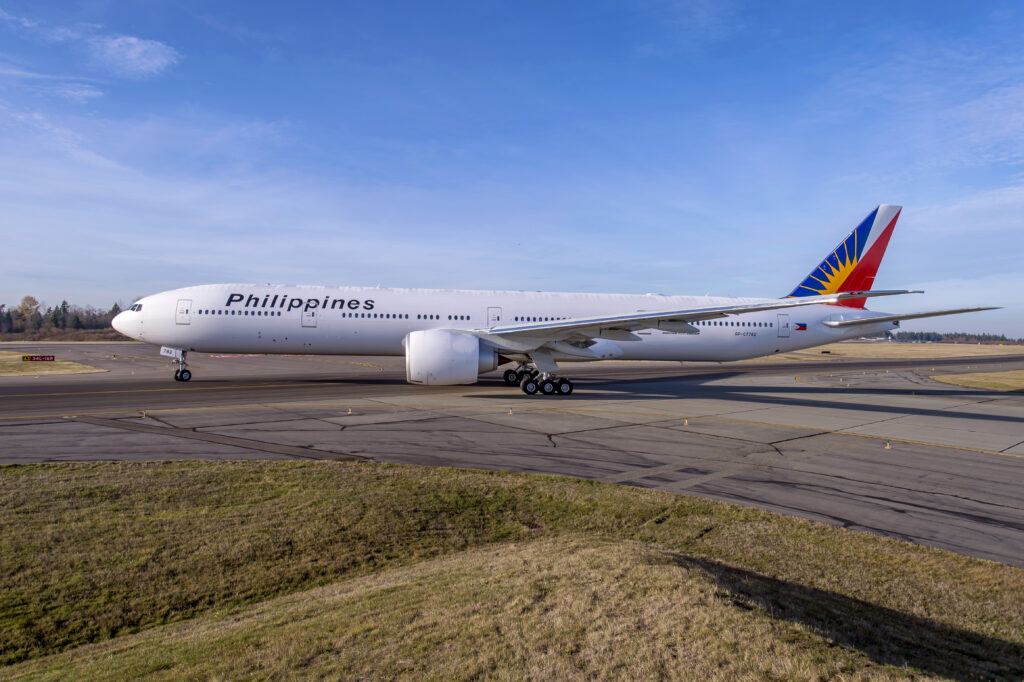
VP and chief engineer of Sustainability & Future Mobility at Boeing, Jim Hileman offers insights into the company’s priorities for aircraft development. Pictured above is a 777. (Photos: Boeing)
Jim Hileman, vice president and chief engineer of Sustainability & Future Mobility at Boeing, shared details about next-gen aircraft, new technologies, operational efficiency, and more in an interview with Avionics International. This is Part 1 of a two-part Q&A series with Jim Hileman. Part 2 features a discussion of Boeing’s approach to sustainability (read Part 2 here).
Avionics International: What are some of Boeing’s priorities in developing the next generation of aircraft?
Jim Hileman: We’re making steady progress across our development programs, including the 737-7, 737-10, 777-9, and 777-8F.
When positioning for our future, we are focused on the technology and capabilities that we need to ensure our next products deliver a generational leap in capability for our customers and reshape our markets.
We’re significantly increasing our research and development over these next several years, and much of that will be focused on our capabilities: producibility, digital, sustainability, and autonomy.
We expect to be in a position to introduce a new airplane sometime in the middle of the next decade.

Boeing 737 MAX
Avionics International: How does Boeing ensure the safety and reliability of new technologies implemented in aircraft?
Jim Hileman: Safety is the primary consideration when Boeing engineers design an airplane or incorporate new technologies.
In addition to meeting regulatory requirements before certification, each airplane must meet Boeing’s design standards. Often these standards are more stringent than regulatory requirements.
New technologies are subject to robust processes that ensure safety throughout design, testing, certification, and operation.

747-8F
Avionics International: How does Boeing approach the challenge of noise reduction in aircraft?
Jim Hileman: Boeing has an active research program to look for innovative ways to reduce noise from aircraft and the Boeing ecoDemonstrator program has played an integral role, testing noise technologies in the cabin and on the outside of the airplane, in addition to testing operational efficiency maneuvers to reduce noise around airports and communities.
Almost every ecoDemonstrator test platform has conducted noise testing, including comprehensive noise testing in partnership with NASA on the 2020 ecoDemonstrator, an Etihad Airways 787-10 Dreamliner.
Boeing is collaborating with many organizations around the world to reduce aircraft noise through improved operational procedure concepts for our current aircraft as well as advancing new lower noise technologies for future aircraft.
The certification noise levels for all aircraft are published and publicly available. New aircraft families have smaller footprints than the aircraft they replace.
For example, the noise footprint of the 737 MAX is 50% smaller than that of a 737NG.
The cumulative certified noise levels for the 787 (introduced in 2011), which is created by an aggregate of three separate noise measurements on approach and takeoff, is roughly 60 dB lower than the comparable value of the 707 (introduced in 1958). While it is difficult to put this into percentages, this equates to approximately a 90% reduction in the noise footprint area.

737 MAX
Avionics International: What advancements in aircraft technology might be coming in the next decade? How will these advancements impact the efficiency and performance of aircraft?
Boeing continues to advance its four strategic pathways to reduce emissions: fleet renewal, renewable energy, advanced technologies, and operational efficiency.
Fleet renewal
New airplanes provide significant efficiency gains, and each generation of fleet renewal reduces fuel use and emissions. Some examples:
737 MAX: Powered by CFM International LEAP-1B engines and incorporating an optimized aerodynamic design, the 737 MAX reduces fuel use and emissions by 20% compared to the airplanes it replaces.
787 Dreamliner: The 787 has best-in-class economics, including 25% lower fuel consumption and emissions than the airplanes it replaces.
777X: With new breakthroughs in aerodynamics and engines, the 777X will deliver 10% lower fuel use and emissions and 10% lower operating costs than the competition. With advanced technology from the new 777X and proven performance from the 777 Freighter, the new 777-8 Freighter offers the highest payload and lowest fuel use, emissions, and operating costs per tonne of any large freighter.
Renewable energy
We are doing everything we can to enable the use of 100% SAF [sustainable aviation fuel] as soon as possible.
[Read more about Boeing’s approach to sustainability in Part 2 of this Q&A.]
Advanced technologies
Electric propulsion: In this decade, battery technology will enable electric aircraft for urban air mobility, such as the self-flying, battery-electric aircraft being certified by Wisk. Boeing will continue to pursue and increase electrification on our platforms when these systems provide an opportunity to optimize energy management on the aircraft and increase overall airplane performance and efficiency.
An example of this is the more-electric architecture introduced on the 787 Dreamliner, which produces 1.45 megawatts of electrical power, more than five times the power on a current 767.
Operational efficiency
Boeing is working with air traffic controllers in multiple regions to optimize an airplane’s flight path, from takeoff to touchdown.
Boeing partnered with air navigation service providers in Japan, Singapore, Thailand, and the U.S. on a test demonstration in June 2023, called multi-regional Trajectory Based Operations (MR TBO) to improve operational efficiency with its first ecoDemonstrator Explorer, a 787-10 Dreamliner.